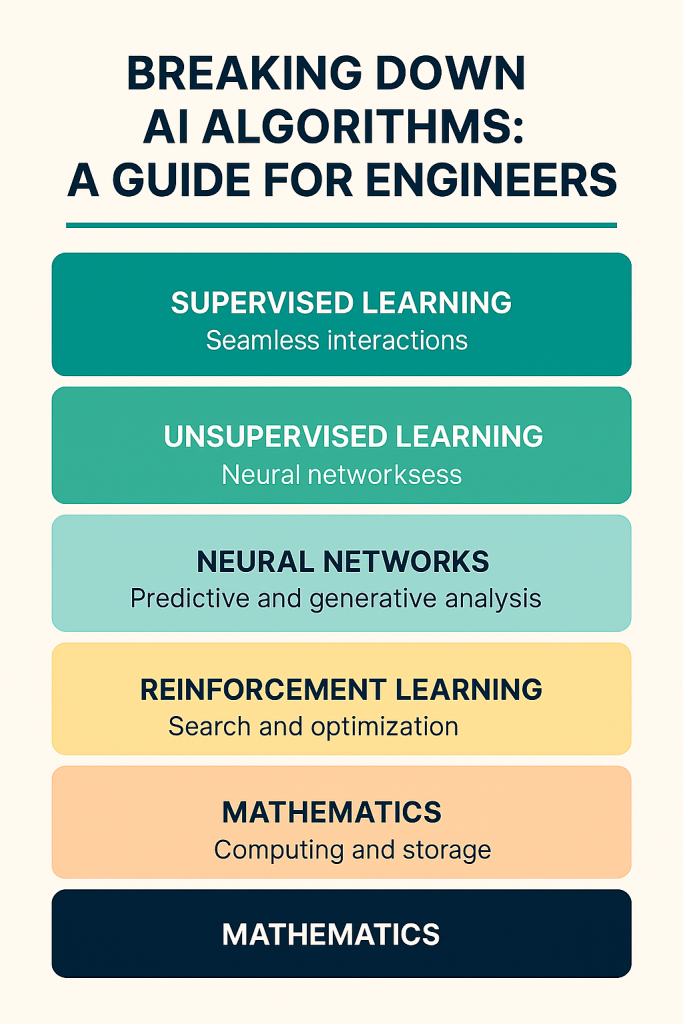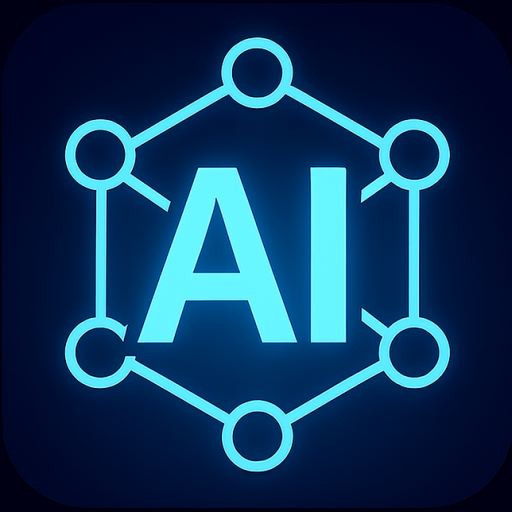Breaking Down AI Algorithms: A Guide for Engineers
Artificial Intelligence (AI) algorithms form the backbone of modern intelligent systems. For engineers, understanding these algorithms is not just about theory but about applying them to solve real-world problems in domains such as manufacturing, energy, healthcare, and finance. This guide provides a detailed breakdown of AI algorithm categories, their mathematical foundations, engineering applications, and practical considerations for implementation.

1. Understanding AI Algorithms
AI algorithms are computational procedures that enable machines to perform tasks that typically require human intelligence, such as learning from data, recognizing patterns, making predictions, and adapting to new information. They can be broadly classified by their learning paradigm:
- Supervised Learning – Models learn from labeled datasets to predict outcomes.
- Unsupervised Learning – Models find patterns in unlabeled data.
- Reinforcement Learning – Agents learn optimal actions through trial and error in an environment.
- Hybrid and Specialized Approaches – Combinations or domain-specific adaptations.
For engineers, the choice of algorithm depends on the problem type, data availability, computational constraints, and performance requirements.
2. Core Categories of AI Algorithms
2.1 Search and Optimization Algorithms
These are foundational in AI for exploring solution spaces and finding optimal or near-optimal answers.
- Uninformed Search: Depth-First Search, Breadth-First Search, Uniform Cost Search.
- Informed Search: A* Search, Greedy Best-First Search, Iterative Deepening A*.
- Optimization: Genetic Algorithms, Simulated Annealing, Particle Swarm Optimization.
Engineering use case: Optimizing component layouts in mechanical design to minimize weight while maintaining structural integrity.
2.2 Supervised Learning Algorithms
Used when historical data with known outcomes is available.
- Linear Models: Linear Regression, Logistic Regression.
- Decision Trees and Random Forests: Interpretable models for classification and regression.
- Support Vector Machines (SVMs): Effective for high-dimensional spaces.
- Neural Networks: Flexible models for complex, non-linear relationships.
Engineering use case: Predictive maintenance in manufacturing by training models on sensor data to forecast equipment failures.
2.3 Unsupervised Learning Algorithms
Applied when the goal is to discover hidden structures in data.
- Clustering: K-Means, DBSCAN, Hierarchical Clustering.
- Dimensionality Reduction: Principal Component Analysis (PCA), t-SNE, UMAP.
- Association Rule Learning: Apriori, FP-Growth.
Engineering use case: Grouping similar material samples based on spectral analysis to identify quality variations.
2.4 Neural Network-Based Algorithms
Neural networks are the foundation of deep learning.
- Feedforward Neural Networks (FNNs): Basic architecture for regression and classification.
- Convolutional Neural Networks (CNNs): Specialized for image and spatial data.
- Recurrent Neural Networks (RNNs) and LSTMs: Designed for sequential data.
- Transformers: State-of-the-art for natural language processing and increasingly used in time-series forecasting.
Engineering use case: Using CNNs for automated defect detection in product images on assembly lines.
2.5 Reinforcement Learning Algorithms
Focus on learning optimal policies through interaction with an environment.
- Value-Based: Q-Learning, Deep Q-Networks (DQN).
- Policy-Based: REINFORCE, Proximal Policy Optimization (PPO).
- Actor-Critic Methods: Combine value and policy learning.
Engineering use case: Autonomous robotic arms learning to optimize assembly sequences for speed and accuracy.
3. Mathematical Foundations Engineers Should Know
- Linear Algebra: Matrix operations underpin neural networks and dimensionality reduction.
- Probability and Statistics: Essential for understanding model uncertainty and Bayesian methods.
- Calculus: Gradient-based optimization relies on derivatives.
- Optimization Theory: Convex optimization, Lagrange multipliers, and stochastic gradient descent.
4. Practical Considerations for Engineers
4.1 Data Quality and Preprocessing
AI models are only as good as the data they are trained on. Engineers must ensure:
- Removal of noise and outliers.
- Normalization or standardization of features.
- Handling missing values appropriately.
4.2 Model Selection and Evaluation
Choosing the right algorithm involves:
- Matching algorithm capabilities to problem requirements.
- Using cross-validation to assess generalization.
- Evaluating with metrics relevant to the application (e.g., precision, recall, RMSE).
4.3 Computational Constraints
Engineers must balance accuracy with resource usage:
- On-device AI for low-latency applications.
- Cloud-based AI for scalability.
- Hybrid approaches for sensitive data or cost control.
4.4 Interpretability and Explainability
In regulated industries, engineers must be able to explain model decisions. Techniques include:
- Feature importance analysis.
- SHAP (SHapley Additive exPlanations) values.
- LIME (Local Interpretable Model-agnostic Explanations).
5. Trends in AI Algorithms for Engineering
- Physics-Informed Neural Networks (PINNs): Integrating physical laws into AI models for better generalization in engineering simulations.
- Generative AI for Design: Using generative models to create optimized prototypes.
- Federated Learning: Training models across decentralized data sources without sharing raw data.
- AutoML: Automating model selection and hyperparameter tuning.
6. Conclusion
For engineers, AI algorithms are not abstract academic constructs but practical tools that can transform workflows, improve product quality, and reduce costs. Mastery involves understanding the mathematical foundations, knowing when to apply each algorithm, and being aware of the trade-offs in performance, interpretability, and computational requirements.
The future will see even tighter integration of AI into engineering processes, with algorithms becoming more specialized, interpretable, and aligned with domain-specific constraints.

Leave a Reply